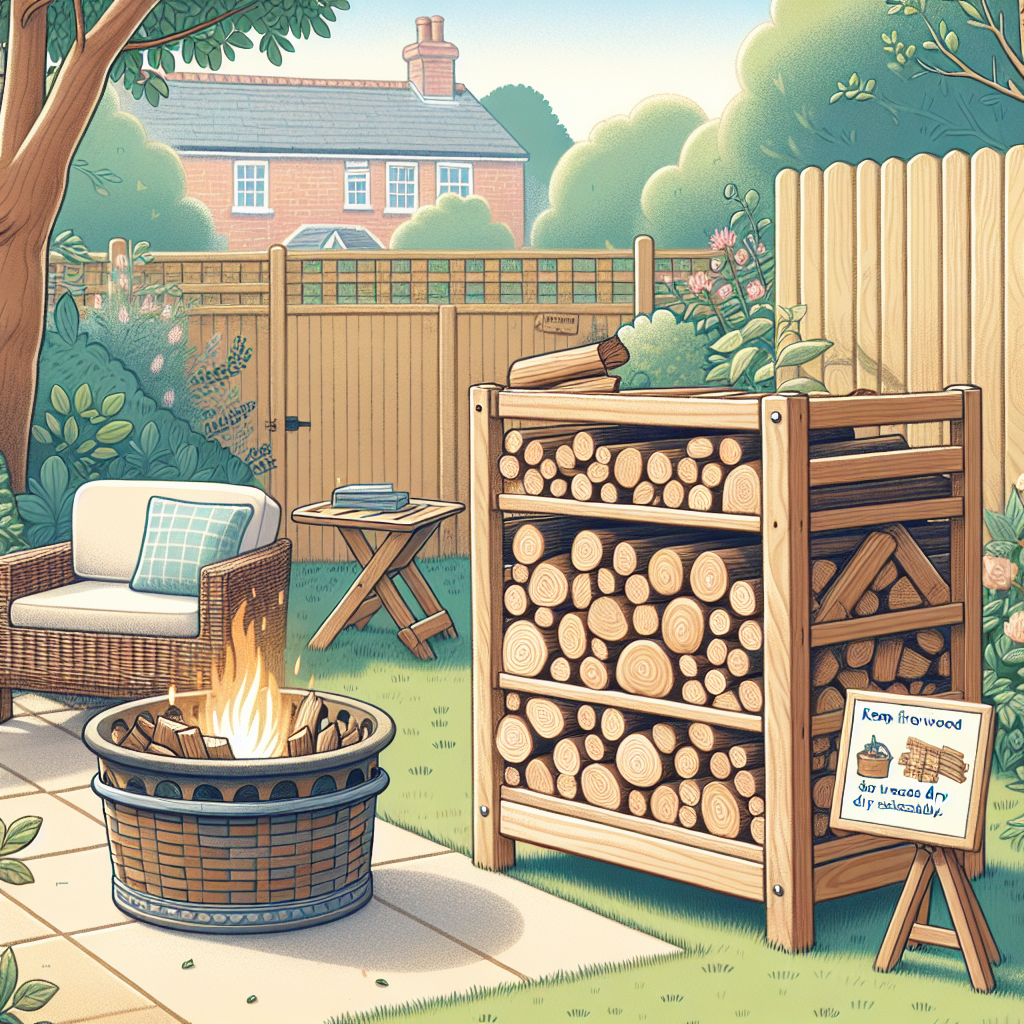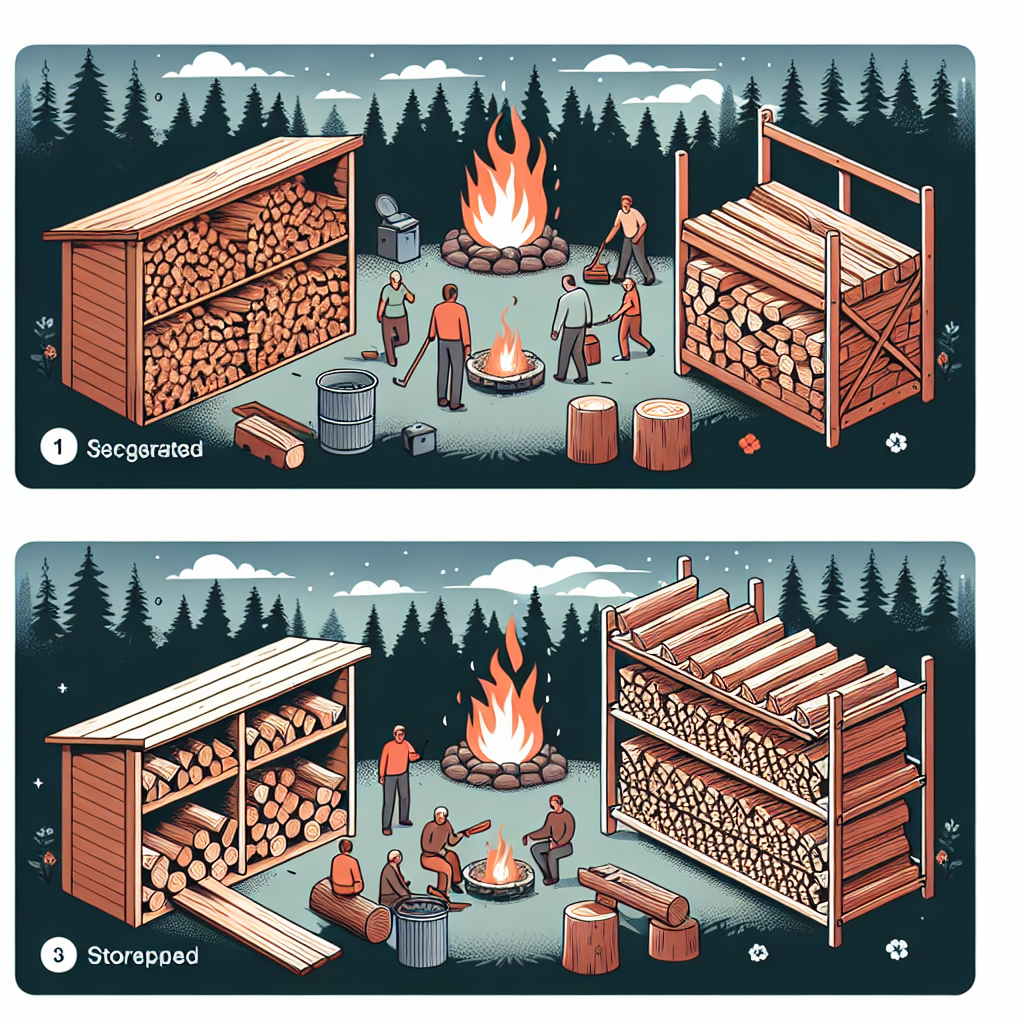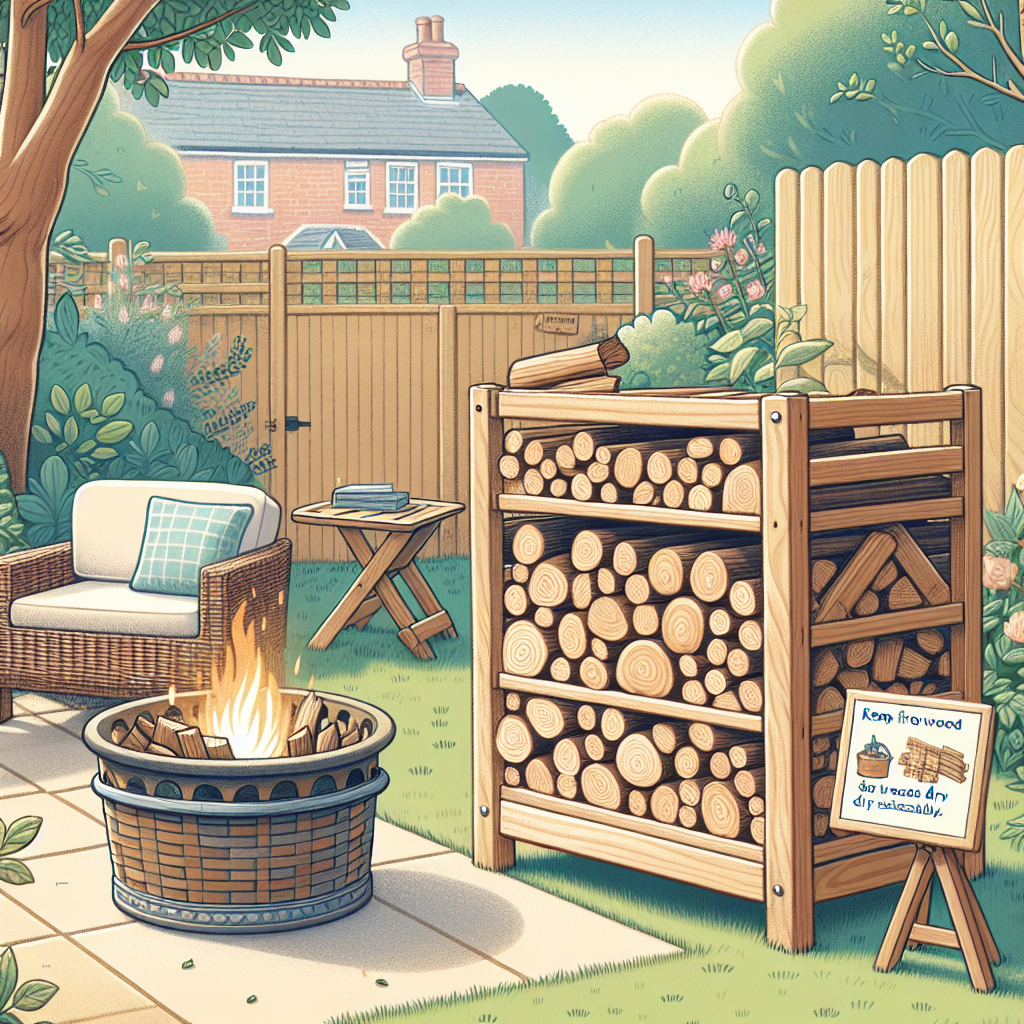Having a fire pit in your backyard is a wonderful way to create a cozy and inviting ambiance during chilly evenings. But with the cold weather approaching, you may be wondering how to properly store firewood for your fire pit. Well, fear not! In this article, we will provide you with simple and effective tips on how to store firewood, ensuring it stays dry, well-organized, and ready to fuel those crackling flames whenever you desire. So, let’s dive right in and discover the secrets to keeping your firewood in top-notch condition all season long!

Choosing the Right Firewood
Seasoned Firewood
When it comes to selecting firewood for your fire pit, seasoned firewood is the way to go. Seasoned firewood refers to wood that has been dried for a significant amount of time, typically for at least six months or longer. This drying process reduces the moisture content in the wood, making it easier to ignite and burn efficiently. By using seasoned firewood, you can enjoy a more enjoyable and hassle-free fire pit experience.
Hardwood vs Softwood
Another important factor to consider when choosing firewood is whether to opt for hardwood or softwood. Hardwood, such as oak or maple, tends to be denser and provides a longer burn time, making it a popular choice for fire pits. Softwood, on the other hand, like pine or cedar, ignites quickly but burns faster. Both types of wood have their advantages, so it ultimately comes down to personal preference and availability.
Avoiding Treated or Painted Wood
It is crucial to avoid using treated or painted wood in your fire pit. Treated wood often contains chemicals that can release harmful fumes when burned, posing a health risk. Painted wood, on the other hand, can release toxic chemicals into the air when exposed to high temperatures. To ensure the safety of yourself and those around you, always stick to using untreated and unpainted firewood.
Ideal Firewood Length
When preparing firewood for your fire pit, it is essential to consider the ideal length of the logs. The general recommendation is to cut the firewood into lengths of about 16 to 18 inches. This length allows for easy stacking and handling while providing sufficient burn time. However, it is essential to adjust the length based on the dimensions of your fire pit and personal preferences.
Preparing the Storage Area
Finding the Right Location
Before you dive into storing your firewood, finding the right location is key. Look for an area that is close enough to your fire pit for convenience but not so close that it poses a fire hazard. Ideally, the storage area should be well-drained to prevent moisture from seeping into the wood. Additionally, try to select a spot that offers some protection from the elements, such as a shed or a covered area.
Creating a Firewood Rack
To keep your firewood organized and off the ground, creating a firewood rack is a great option. A firewood rack can be as simple as a wooden frame with horizontal bars, allowing for proper airflow and preventing the wood from touching the ground. You can easily build one yourself or purchase a pre-made rack. Whichever option you choose, ensure that the rack is sturdy and can withstand the weight of the firewood.
Clearing Debris and Vegetation
Before placing your firewood in the storage area, it is crucial to clear away any debris or vegetation. Leaves, grass, and other organic materials can become moist and attract pests, compromising the quality of your firewood. Additionally, removing vegetation helps prevent any potential fire hazards. Take the time to sweep the area clean and remove any obstacles that may hinder access to the wood.
Maintaining Proper Air Circulation
When setting up your firewood storage area, it is essential to ensure proper air circulation. Adequate airflow helps to prevent moisture buildup in the firewood, reducing the chances of mold growth or rot. Avoid tightly stacking the firewood together, as this can impede air circulation. Instead, leave some space between the logs to allow air to move freely and promote drying.
Covering and Protecting Firewood
Using Tarps or Firewood Covers
Covering your firewood is vital to protect it from the elements. One option is to use a tarp or firewood cover to shield your firewood from rain, snow, and excessive moisture. When using a tarp, make sure it is large enough to cover the entire stack and secure it tightly to prevent it from blowing away in strong winds. Alternatively, you can invest in specially designed firewood covers that provide optimal protection and ventilation.
Avoiding Moisture Build-up
While covering your firewood is essential, it is equally crucial to avoid moisture build-up underneath the cover. Moisture can accumulate if the cover is not breathable or if it is not properly secured, leading to damp firewood that is challenging to ignite. Ensure that your cover allows for proper airflow and periodically check for any signs of moisture or condensation.
Proper Firewood Stacking Techniques
Stacking your firewood correctly is not only visually appealing but also promotes air circulation and drying. The “rick” method is commonly used, where the logs are stacked in a crisscross pattern. This technique creates stability and allows for air movement between the logs, aiding in the drying process. Avoid stacking the firewood too high to prevent the risk of the stack toppling over.
Protecting Against Pests
Pests can wreak havoc on your firewood, causing damage and reducing its quality. To protect against pests, elevate the firewood off the ground using pallets or a firewood rack. This helps to discourage pests from making a home beneath the wood. Additionally, avoid storing firewood near buildings or vegetation, as it can provide easy access for insects or rodents. Regularly inspect your firewood for signs of pests and take necessary measures to prevent infestations.
Keeping Firewood Dry
Elevating Firewood Off the Ground
One of the best ways to keep your firewood dry is by elevating it off the ground. Direct contact with the ground can lead to moisture absorption, potentially rendering the firewood unusable. Place pallets, bricks, or other sturdy materials underneath the firewood stack to ensure it remains elevated and protected from ground moisture.
Using Firewood Racks or Pallets
As mentioned earlier, using firewood racks or pallets is an effective method for keeping your firewood dry. These structures provide ample airflow and prevent the wood from absorbing moisture from the ground. By keeping the firewood off the ground and allowing air to circulate freely around it, you can significantly reduce the risk of moisture-related issues.
Creating a Roof or Shelter
If your storage area is exposed to the elements and lacking cover, consider creating a roof or shelter specifically for your firewood. This can be a simple structure made from wood, metal, or even a tarp stretched over a frame. By providing protection from rain and snow, you can prevent excess moisture from seeping into the firewood, ensuring it remains dry and ready to use.
Using Drying Techniques
If you find that your firewood has a higher moisture content than desired, there are drying techniques you can employ to expedite the drying process. One method involves splitting the wood into smaller pieces, which increases the surface area and promotes faster drying. Additionally, you can use a firewood moisture meter to monitor the moisture levels and rotate the firewood periodically to ensure even drying.

Maintaining Firewood Safety
Keeping Firewood Away from Structures
To ensure fire safety, it is crucial to keep your firewood stack a safe distance away from any buildings or structures. Embers or sparks from the fire pit can inadvertently ignite the firewood, posing a significant fire hazard. Aim to keep the firewood at least 30 feet away from any structures to minimize the risk of fire spreading.
Maintaining Safe Distance from Fire Pits
When storing firewood near your fire pit, it is essential to maintain a safe distance to prevent accidents or injuries. Keep the firewood stack at a reasonable distance from the fire pit to minimize the risk of logs falling into the fire or sparks igniting the wood prematurely. A good rule of thumb is to keep the stack at least three to five feet away from the edge of the fire pit.
Inspecting for Insects or Mold
Regular inspections of your firewood stack are crucial to ensure that it remains pest and mold-free. Periodically check the logs for any signs of insects, such as wood-boring beetles or termites, and promptly address any infestations. Additionally, look out for mold growth on the firewood, as moldy logs can release harmful spores into the air when burned.
Replacing Old or Rotted Wood
Over time, firewood can deteriorate, become rotted, or lose its ability to burn efficiently. It is important to regularly inspect your firewood for signs of decay, such as softness, discoloration, or an unpleasant odor. If you come across any compromised logs, it is best to replace them promptly to ensure you have a steady supply of quality firewood.
Minimizing Moisture Content in Firewood
Splitting Firewood to Promote Drying
Splitting firewood into smaller pieces is an effective way to promote drying. By exposing a greater surface area to air, the wood can dry more quickly. Splitting larger logs can also make the firewood easier to handle and ignite. Use a splitting maul or a hydraulic log splitter to safely and efficiently split the firewood into manageable sizes.
Storing Firewood in a Dry Season
If possible, aim to stock up on firewood during a dry season. Wood that has been harvested and stored during dry periods tends to have a lower moisture content, making it easier to ignite and burn efficiently. Take advantage of the weather conditions to ensure you have well-seasoned firewood for optimal performance in your fire pit.
Covering the Top of Firewood Piles
While it is important to cover your firewood stack to protect it from moisture, it is equally important to cover the top of the pile. By covering the top, you can prevent rain or snow from seeping into the stack, minimizing the chances of the top logs becoming damp or difficult to ignite. A tarp or firewood cover can be used to cover the top of the pile securely.
Using Wood That Has Been Dried for Long Periods
If you have the option, using firewood that has been dried for an extended period is highly recommended. Wood that has been seasoned for longer durations typically has a lower moisture content, resulting in easier ignition and a cleaner burn. If possible, opt for firewood that has been dried for at least one year, as this allows for optimal burning properties.

Stacking Firewood Properly
Creating Stable Firewood Piles
Stacking your firewood in stable piles is crucial for both efficient storage and safety. Start by creating a solid base with larger logs, ensuring that they are aligned evenly to provide stability. As you stack additional layers, alternate the direction of the logs to create a crisscross pattern. This method helps the stack maintain its stability and allows for adequate airflow.
Stacking Firewood in Rows
To maximize storage space and ease of access, consider stacking your firewood in rows. Start by creating a base row, ensuring that the logs are aligned parallel to each other. As you build subsequent rows, offset the logs to create a staggered pattern. This technique not only creates a visually appealing stack but also allows for proper airflow and accessibility to individual logs.
Utilizing Cross-Stacking Method
Cross-stacking is another stacking method that can be used to enhance stability and air circulation. Start by placing two base logs parallel to each other, with a gap in between. Place additional logs perpendicular to the base logs, alternating the direction with each layer. This cross-stacking technique creates interlocking layers that provide excellent stability and allow for efficient drying.
Maximizing Storage Space
If you have limited space, it is essential to maximize your firewood storage. Utilize vertical space by building taller stacks, but ensure they remain stable and secure. Alternatively, consider using wall-mounted storage racks or even designated firewood sheds to make the most of your available space. By maximizing storage capacity, you can have an ample supply of firewood for seamless enjoyment of your fire pit.
Protecting Firewood from Pests
Keeping Firewood Away from Buildings
To prevent pests from making their way into your home, it is crucial to keep the firewood stack at a safe distance from any buildings. Storing firewood against the exterior of your home can create a pathway for insects or rodents to infiltrate your living space. Aim to keep the firewood stack at least 30 feet away from any structures and regularly inspect the stack for signs of pests.
Inspecting Firewood for Signs of Pests
Inspecting your firewood regularly is key to catch any signs of pests early on. Look for small holes or burrows in the logs, as this could indicate the presence of wood-boring beetles or termites. Additionally, keep an eye out for insect eggs or larvae. If you come across any signs of pest activity, take immediate action to prevent the infestation from spreading.
Using Insect Repellents or Barriers
To protect your firewood from pests, you can utilize insect repellents or barriers. There are specific insecticides available that can be sprayed onto the firewood to deter pests. However, ensure that the insecticide used is safe for use with firewood and will not contaminate the air when burned. Physical barriers, such as insect screens or mesh, can also be employed to prevent pests from accessing the firewood.
Regularly Cleaning the Storage Area
Maintaining a clean storage area is essential for preventing pests from infesting your firewood. Regularly clean the area around your firewood stack, removing any debris or organic matter that can attract pests. Sweep away fallen leaves, clean up any spilled wood chips, and remove any dead insects or rodents from the vicinity. By keeping the storage area clean, you can minimize the risk of pest infestations.

Monitoring Firewood Quality
Rotating Firewood Stock
To ensure that your firewood remains in optimal condition, it is advisable to rotate your stock regularly. Use the “first in, first out” principle, where you use the oldest firewood first and replenish your supply with fresh logs. By rotating your firewood, you can prevent logs from sitting for extended periods and allow for proper drying and seasoning.
Inspecting Firewood for Signs of Decay
Regular inspections of your firewood stack are crucial to identify any signs of decay or deterioration. Look for soft spots, discolored areas, or a foul odor, as these can indicate rot or mold growth. If you come across any compromised logs, promptly remove them from your stack to prevent the spread of decay to the rest of the firewood.
Checking for Proper Moisture Content
Firewood with a high moisture content can be difficult to ignite and burn efficiently. To ensure optimal firewood performance, it is beneficial to periodically check the moisture content of your logs. A moisture meter can be used to measure the moisture level and determine if further drying is necessary. Aim for a moisture content of around 20% or lower for well-seasoned firewood.
Avoiding Moldy or Rotten Firewood
Using moldy or rotten firewood is not only unpleasant but can also release harmful spores into the air when burned. Avoid using any firewood that shows signs of mold growth or has a rotten smell. Burning such wood can pose health risks and compromise the quality of your fire pit experience. Always prioritize using well-seasoned and high-quality firewood.
Using Firewood Efficiently
Properly Seasoned Firewood for Optimal Burn
To maximize the efficiency of your firewood and ensure a consistent burn, it is crucial to use properly seasoned firewood. Well-seasoned firewood has a lower moisture content, allowing it to ignite more easily and burn cleaner. The process of seasoning firewood typically involves drying it for at least six months to a year. By using properly seasoned firewood, you can enjoy longer burn times and less smoke.
Starting with Small Kindling
When starting a fire in your fire pit, it is best to begin with small kindling. Kindling consists of small twigs or sticks that ignite quickly and provide a base for the larger logs to catch fire. Starting with kindling allows for a more controlled ignition and helps establish a strong and steady fire. Layer the kindling in a crisscross pattern and gradually add larger pieces of firewood as the fire grows.
Layering Firewood for Steady Burning
To maintain a steady burning fire, it is important to layer your firewood effectively. Start with a base layer of larger logs, ensuring they are placed parallel to each other for stability. As you build on the base layer, alternate the direction of the logs in subsequent layers to create gaps for airflow. This layering technique promotes efficient combustion and helps the fire burn steadily.
Avoiding Overloading the Fire Pit
While it may be tempting to load your fire pit with an abundance of firewood, it is important to avoid overloading it. Overloading the fire pit can hinder airflow and lead to inefficient burning. It is best to add a moderate amount of firewood at a time, ensuring there is sufficient space between the logs for oxygen to reach the fire. By maintaining proper airflow, you can achieve a more efficient and consistent burn.
In conclusion, storing firewood properly is crucial to ensure a safe and enjoyable fire pit experience. By choosing the right firewood, preparing the storage area, covering and protecting the firewood, keeping it dry, maintaining safety, minimizing moisture content, stacking it properly, protecting against pests, monitoring quality, and using it efficiently, you can maximize the performance and longevity of your firewood while minimizing risks and maximizing enjoyment. With these tips in mind, you can confidently store your firewood and look forward to cozy evenings around your fire pit.



